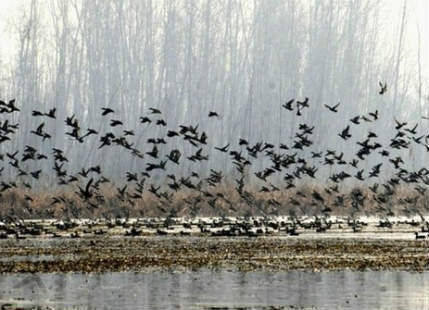Owing to warmer temperatures and decreased precipitation in Kashmir this winter, migratory birds have started leaving the Himalayan valley early this year
Wildlife officials say that there has been a marginal decrease in the number of migratory birds this year, compared to last winter, as there has been a dip in rain and snowfall.
This was observed in a census of migratory and other endemic birds nesting in the valley wetlands conducted by wildlife officials and experts on February 12. “We are yet to arrive on the final figures, but approximate figure of migratory birds this year is around 10 lakh, compared to 11 lakh last year. This winter has been relatively warm and precipitation was less, hence the marginal decrease,” said wildlife warden, wetlands, Ifshan Dewan.
The census was conducted across the wetlands of the Kashmir valley and was a collaborative effort of the wildlife department, wildlife conservation societies, NGOs, and educational institutions life Kashmir University, Sheri Kashmir Agricultural University of Science and Technology, and Degree College, Pampore.
Ifshan said that more birds were present in the Valley before the census on Saturday and the warm weather had its impact. “Currently, there are fewer birds in Hokersar wetland. In Pampore, the wetlands were teeming with birds, but some of them have now left the region. There has been a dry spell this winter as well,” she said. Kashmir has around 400 water bodies, of which 25 are the winter haunt of migratory birds.
Shalbough in central Kashmir’s Ganderbal district is the biggest wetland spread over 16 square kilometres, Hokersar on the city’s outskirts covers around 13.5 square kilometres, while Hygam in north Kashmir is spread across nine square kilometres. Chatlam wetland in south Kashmir’s Pampore also attracts several migratory species. The birds travel from the colder areas of the world, flying over continents in flocks. The birds that arrive here every year between October and April include mallards, greylag geese, pochards, common tails, shovelers, pintails and gharwals.
Dewan said that they sighted many new species of waders, also called shorebirds and a white-fronted goose. However, she said that some birds have given the region a miss this year. “Tundra species were not sighted this year. However, some 10 to 15 types of wader species have arrived here, which like to perch near shores,” she said.
Vigilance stepped up in wetlands to stop poaching
The wetlands in the valley had seen large-scale poaching of migratory birds during the early years of militancy. However, now vigilance has been stepped up and encroachments on wetlands have also come down to a large extent. The wildlife department has also established control rooms to stop the poaching of birds.
Dewan said that they are still hopeful of the arrival of other migratory birds, as there is still time for the winter to end. “In warmer winters, these things (marginal decrease in birds) happen. We are still hopeful that more birds may arrive,” she said.
Kashmir’s winter pans out in three stages starting from late December, with the harshest 40-day period called Chillai Kalan ending on January 30. Currently, the Valley is going through 20 days of Chillai Khurd or a moderate cold period which will be followed by 10 days of a mild cold. Overall, this Chillai Kalan was warmer and comparatively better than the past few years, as per meteorologists.
The weather office has predicted erratic weather for the next one week with chances of rains and snow from Wednesday.




